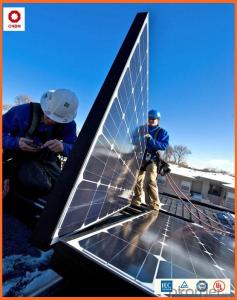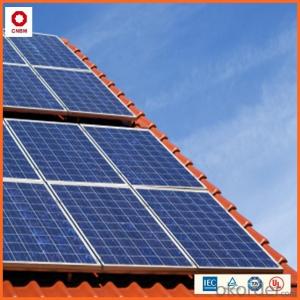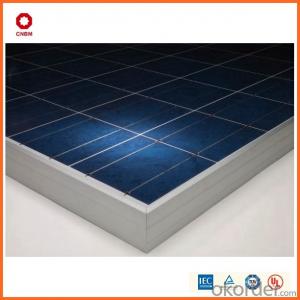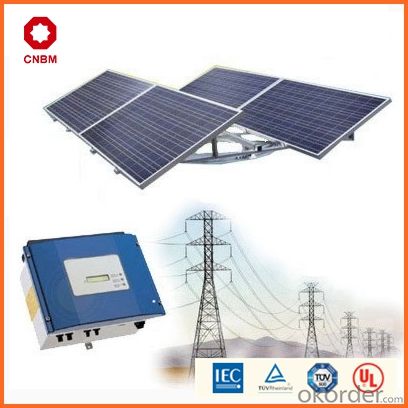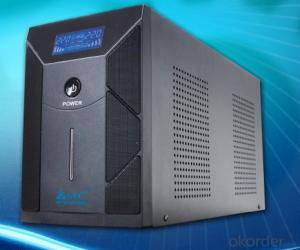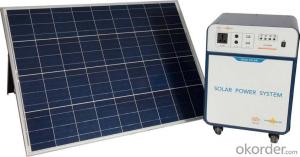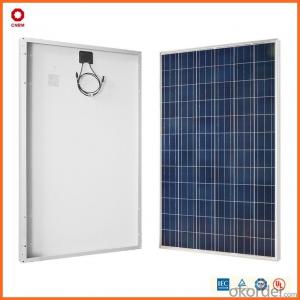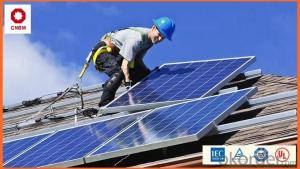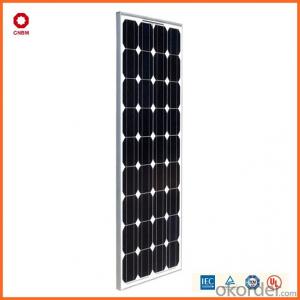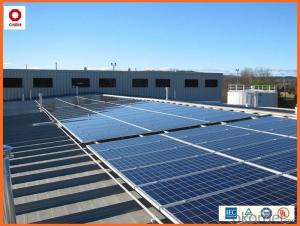Maryland Solar Energy Systems 45w Small Solar Panels in Stock China Manufacturer
- Loading Port:
- China main port
- Payment Terms:
- TT OR LC
- Min Order Qty:
- 1 watt
- Supply Capability:
- 10000000 watt/month
OKorder Service Pledge
OKorder Financial Service
You Might Also Like
Specification
Product Description:
Hot Sale !!! Quality and Safety of Small Poly Solar Panel 5w~150w
1. Rigorous quality control meets the highest international standards.
2. High-transmissivity low-iron tempered glass, strong aluminium frame.
3. Using UV-resistant silicon.
4. IS09001/14001/CE/TUV/UL
Warranties of Small Poly Solar Panel 35~85w
1. 10 years limited product warranty
2. 15 years at 90% of the minimal rated power output
3. 25 years at 80% of the minimal rated power output
Specification
Characteristics of Poly solar panels CNBM (245-320W) | |||||
Max Power Voltage Vmp(V) | 30.3 | 30.8 | 31.1 | 31.4 | 31.85 |
Max Power Current Imp(A) | 7.60 | 7.64 | 7.73 | 7.81 | 7.85 |
Open Circuit Voltage Voc(V) | 36.1 | 36.6 | 37 | 37.3 | 37.68 |
Short Circuit Current Isc(A) | 8.50 | 8.55 | 8.65 | 8.75 | 8.85 |
Max Power Pm(W) | 230W | 235W | 240W | 245W | 250W |
Temperature Coefficient of Cells Poly solar panels CNBM (245-320W) | |
NOCT | 45± 2 |
Temperature Coeffucients of Isc | 0.0492 |
Temperature Coeffucients of Voc | -0.3374 |
Temperature Coeffucients of Voc | -0.4677 |
Mechanical Data of Poly solar panels CNBM (245-320W) | |
Dimension | 1638 × 982 × 40 mm |
Weight | 19.5 kg |
No. of Cells and Connections | 60 (6 ×10) |
Tolerance | 0 ~ + 5 W |
Cell | Monocrystalline Cell 156 × 156 mm |
Packing | 624 Pcs/40ft(H) Container |
Limits of Poly solar panels CNBM (245-320W) | |
Operating Temperature | -40 to +85 |
Storage Temperature | -40 to +85 |
Max System Voltage | 1000VDC(IEC) / 600VDC(UL) |
Features of our products:
• High conversion efficiency mono/poly-crystalline amorphous silicon solar cells
• Modules incorporate high performance bypass diodes to minimize the power drop caused by shading
• High transmittance, low-iron tempered glass
• High performance EVA encapsulant to prevent destroying and water.
• AI frame: without screw, corner connection. 8 holes on the frame can be installed easily
• Good performance of preventing from atrocious weather such as wind and hails
• Certifications: CE IEC TUV VDE UL, Class I
• 10 years 90% power output warranty

Shipping of Small Poly Solar Panel 35~85w
By Sea | Delivery from Shanghai or Ningbo seaport |
By Air | Departure from Shanghai Pudong Airport |
By Express | Post by DHL, EMS, UPS, TNT. |
Features of our products:
• High conversion efficiency mono/poly-crystalline amorphous silicon solar cells
• Modules incorporate high performance bypass diodes to minimize the power drop caused by shading
• High transmittance, low-iron tempered glass
• High performance EVA encapsulant to prevent destroying and water.
• AI frame: without screw, corner connection. 8 holes on the frame can be installed easily
• Good performance of preventing from atrocious weather such as wind and hails
• Certifications: CE IEC TUV VDE UL, Class I
• 10 years 90% power output warranty
As a professional Solar Panel manufacturer and Supplier in China, we have our customers come around the whole world and our specialization has got a worldwide recognition. Meanwhile, with our superior quality, competitive price, prompt and excellent service, As main role in trade section of CNBM Group, CNBM International Corporation supplies products including Monocrystalline Solar Panel, Polycrystalline Solar Panel ( multicrystalline silicon Solar Panel) have received and enjoyed famous reputation in many countries and regions in the world.
- Q: What is the role of solar energy systems in reducing energy inequality?
- Affordable and sustainable energy sources are made accessible to underserved communities or those lacking reliable electricity through solar energy systems, thereby reducing energy inequality. Solar energy systems offer scalability, making them suitable for large-scale installations and small-scale community projects. This adaptability enables their deployment in rural areas with limited or unreliable grid infrastructure, improving the lives of people in these communities by providing electricity to homes, schools, and healthcare facilities. Moreover, solar energy systems can be installed on rooftops, reducing the need for additional land and minimizing environmental impact. This is particularly crucial in urban areas where space is limited and conventional energy sources like coal or gas are more polluting and harmful to human health. By reducing air pollution and associated health issues, solar energy systems create a cleaner and healthier environment. Decentralized energy production is another significant aspect of solar energy systems. Instead of relying solely on distant large power plants, solar energy systems promote distributed generation, allowing electricity to be produced and consumed locally. This decentralization empowers communities, reducing their dependence on centralized grids and volatile energy prices. Solar energy systems also bring economic opportunities and lower energy costs to marginalized communities. By investing in solar installations, communities can generate income by selling excess energy back to the grid, creating local job opportunities and fostering economic development. Additionally, solar energy systems help reduce household energy bills, freeing up financial resources for other essential needs. In conclusion, solar energy systems play a vital role in reducing energy inequality by providing equitable access to affordable, sustainable, and clean energy sources. By addressing energy poverty and promoting self-sufficiency, solar energy systems contribute to a more inclusive and sustainable future for all.
- Q: I want to install a full set of domestic solar heating equipment does not know how much money to spend, please.
- This area of solar heating system is divided into 4 parts: solar panels. Thermal energy water storage device. Thermal converter. Auxiliary heating wall. This system can be added with winter heating of buildings above 50% hot heat as a heat source for heating indoor floor heating systems, the spring and autumn three season can use gas or not using gas assisted heating (heat storage water tank can not increase the gas heating can be all-weather hot water).
- Q: What is the impact of air pollution on solar panel efficiency?
- Air pollution has a negative impact on solar panel efficiency as it reduces the amount of sunlight reaching the panels, thereby decreasing their energy generation capacity. Dust, smog, and other particles in the air create a layer on the surface of the panels, hindering the absorption of sunlight. Regular cleaning and maintenance are required to ensure optimal efficiency and performance of solar panels in areas with high air pollution.
- Q: Are there any government incentives or tax credits for installing a solar energy system?
- Yes, there are government incentives and tax credits available for installing a solar energy system. These incentives and credits vary by country and region, but they often include federal tax credits, state or local rebates, grants, and incentives that aim to promote the adoption of renewable energy sources. It is advisable to research and consult with local authorities or a tax professional to determine the specific incentives and credits available in your area.
- Q: How do solar energy systems impact the demand for traditional energy sources?
- Solar energy systems reduce the demand for traditional energy sources by providing a clean and renewable alternative. As more solar energy is generated and integrated into the grid, the need for fossil fuels and other non-renewable sources decreases, leading to a decrease in overall demand for traditional energy sources.
- Q: Can solar energy systems be used in powering agricultural processing facilities?
- Yes, solar energy systems can be used to power agricultural processing facilities. Solar panels can be installed on the rooftops or surrounding land of these facilities to generate electricity. This renewable energy source can provide a reliable and cost-effective solution to meet the power requirements of various agricultural processing operations, such as drying, milling, refrigeration, and packaging. Additionally, solar energy systems can help reduce greenhouse gas emissions and dependence on fossil fuels, making them an environmentally sustainable choice for powering agricultural processing facilities.
- Q: Can solar energy systems be used in powering recreational facilities like gyms or spas?
- Certainly, solar energy systems are an excellent choice for powering recreational facilities such as gyms and spas. In fact, many of these establishments have already embraced solar energy as a sustainable and cost-effective solution for their energy requirements. The installation of solar panels on the roof or in close proximity to the facility allows for the capture of sunlight and its conversion into electricity. This clean and renewable energy source can then be utilized to power various equipment, including lighting, air conditioning, heating, and other electrical systems within the facility. By incorporating solar energy systems, recreational facilities can significantly reduce their dependence on traditional energy sources, such as fossil fuels. This not only contributes to the reduction of carbon emissions and the fight against climate change but also provides long-term financial advantages. Over time, solar power can result in substantial energy savings, as gyms and spas have the potential to generate their own electricity and even sell any excess power back to the grid. Furthermore, solar energy systems can be seamlessly integrated into the design of recreational facilities. The sleek and modern appearance of solar panels can enhance the overall aesthetic appeal of the facility, while also showcasing its commitment to environmental sustainability. This can attract environmentally conscious customers who appreciate businesses that prioritize renewable energy and contribute to a greener future. In conclusion, solar energy systems are a viable and increasingly popular option for powering recreational facilities like gyms and spas. By harnessing the power of the sun, these facilities can reduce their carbon footprint, save on energy costs, and attract environmentally conscious customers.
- Q: Can solar energy systems be used for powering off-grid research stations in Antarctica?
- Yes, solar energy systems can be used for powering off-grid research stations in Antarctica. Solar panels can be installed to capture and convert sunlight into electricity, which can then be stored in batteries for use during periods of low or no sunlight. This renewable energy source can provide a reliable and sustainable power supply for the research stations, reducing the dependence on fossil fuels and minimizing environmental impact.
- Q: What is the role of solar cookers in solar energy systems?
- Solar cookers play a crucial role in solar energy systems as they harness sunlight to cook food without the need for traditional fuel sources. They utilize the heat from the sun to heat and cook food, reducing the reliance on fossil fuels and minimizing environmental impact. Solar cookers are cost-effective, sustainable, and provide a clean and renewable alternative for cooking, making them an essential component of solar energy systems.
- Q: Can solar energy systems be used in powering fire stations or police stations?
- Yes, solar energy systems can certainly be used to power fire stations or police stations. Solar panels can be installed on the rooftops of these buildings to harness sunlight and convert it into electricity. This renewable energy source can help reduce the reliance on traditional power grids and lower operational costs for these facilities. Additionally, solar energy systems can ensure a more sustainable and environmentally friendly power source for fire and police stations.
Send your message to us
Maryland Solar Energy Systems 45w Small Solar Panels in Stock China Manufacturer
- Loading Port:
- China main port
- Payment Terms:
- TT OR LC
- Min Order Qty:
- 1 watt
- Supply Capability:
- 10000000 watt/month
OKorder Service Pledge
OKorder Financial Service
Similar products
Hot products
Hot Searches
Related keywords
